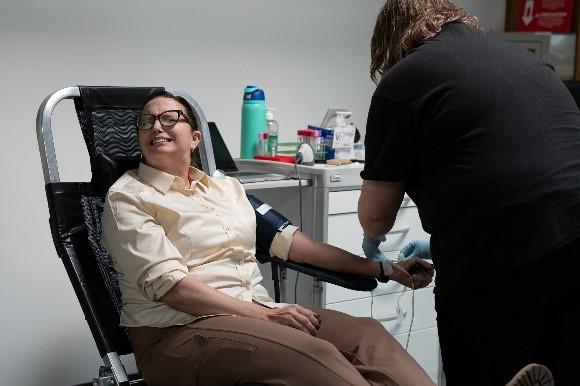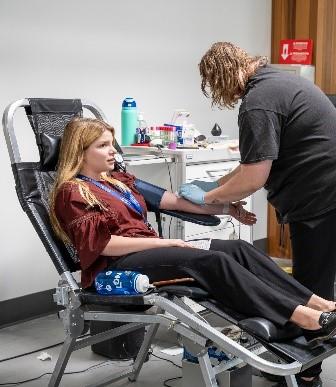
I remember being distraught in the doctor’s office as a child whenever a needle was anywhere within my vicinity. It wasn’t until adulthood that I learned about Trypanophobia, which is defined as an irrational or excessive fear of needles.
Despite having an excessive fear of needles, I’ve always wanted to donate blood. The reason is that I try to help my local community however I can, and the need for blood is ever present. I’ve registered as an organ donor, I’ve donated to charity and fostered dogs, but still hadn’t donated blood.
That was until my Northrop Grumman worksite in Roy, Utah, hosted a blood donation event, which they do every other month in partnership with a statewide nonprofit organization that collects blood for the University of Utah Hospital and the Huntsman Cancer Institute.
What pushed me over the edge was learning that the Utah health care system needs to collect blood from at least 75 donors every day to keep up with the demand and continue saving lives.
Let me share with you my experience as a beginner with blood donation.
Calm, Cool and Collected
The entire process took about an hour. I created an account and scheduled an appointment. After receiving a confirmation email, I was ready to go.
On the day of the appointment, I completed a confidential questionnaire to confirm I was eligible and healthy to donate blood. This process also helps ensure no diseases are passed to recipients.
At the donation site, an employee checked my ID and escorted me to a quiet corner of the room. From there, they measured my blood pressure, pulse and took a small sample of blood using a pin prick on my fingertip to rule out anemia.
The Donation
Next came the hard part. I was asked which arm to use for the needle and as the employees set up their tools, I welcomed any distraction to calm my nerves. Thankfully my colleagues were there to support me, playing the Taylor Swift song, “Bad Blood,” for me while I sat on the gurney and distracted me with small talk.
The employees were professional and kind, sharing that I could stop at any point, and no one would be upset. They applied a large elastic around the top of my arm and gave me a stress ball to squeeze so my veins would be easier to find. They cleaned the crook of my arm and got my vein on the first try. I felt a quick pinch when the needle went in, then a slightly weird sensation that was more uncomfortable than painful, as they started the draw.
This took about 10 minutes as they collected a pint of blood. An employee monitored me the whole time and quickly extracted the needle when done. They put pressure on my arm, placing a cotton ball over the puncture wound and wrapping a bandage around my elbow.
A Refreshing Finish
Next, it was time for refreshments. Being able to stand without getting dizzy, I was guided to a snack table with dozens of goodies including chips, cookies, trail mix bars and juice. According to experts, increasing salt intake after losing blood helps restore blood volume more quickly, and sugar intake helps with dizziness due to low glucose levels.
While snacking, I asked some of my colleagues who donated at the same time what their motivation was. Here’s what they said:
“I’ve been doing it since college,” said Jay Lindstrom, a sentinel systems engineer. “It’s a habit that kind of stuck.”
“Because I can help others,” said John Wright, a senior sentinel systems engineer and chapter co-chair for the African American Task Group Employee Resource Group. My dad has had multiple hospitalizations, and at one point they were telling us that they didn’t have enough blood to give him.”
“I like to give blood because it regenerates and it helps people,” said Jasmine Al-Aidy, sentinel systems engineer. “Not to mention it’s a nice break from work and the snacks they give you after your donation.”
Becoming a Regular
Looking back on this experience, it was nowhere near as traumatic as I thought it would be. In fact, I plan on donating the next time they come around.
If you’re looking for a new way to help your community like I was, consider pledging to support Northrop Grumman’s SleevesUp Campaign or reach out to your Corporate Citizenship Representative.


Carrie Bohnsack (left) and a colleague, Bridget McCole (right), sit comfortably as they participate in a blood donation event sponsored by Northrop Grumman at the Roy, Utah site.
Written by: Carrie Bohnsack